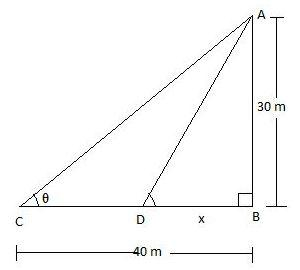Question
Question: A tower of height 30 meters casts a shadow of length 40 meters at a certain instant. When the sun’s ...
A tower of height 30 meters casts a shadow of length 40 meters at a certain instant. When the sun’s elevation increases by tan−171, the length of the shadow cast by the tower, in meters is:
(a) 20
(b) 25
(c) 30
(d) 45
Solution
Assume that the initial angle of inclination of the sun is θ. Now, when the angle of the elevation of the sun is increased by tan−171 then the new angle of elevation becomes: θ+tan−171. Assume the length of the shadow formed in this process as ‘x, here, ‘x’ will be smaller than 40 m. Draw the diagram of the given conditions and use the formula: tan(a+b)=1−tanatanbtana+tanb to equate with tanθ=BasePerpendicular. By substituting all the given values, find the value of ‘x’.
Complete step-by-step answer:
Let us assume that the initial angle of inclination of the sun is θ. When the angle of inclination of the sun increases by tan−171, the new angle of elevation becomes: θ+tan−171. This will lead to a decrease in the length of shadow casted because, tanθ=BasePerpendicular, so as θ increases, the value of base decreases. Assume that the length of shadow casted is ‘x’.
Let us draw that diagram of the given situations.

Clearly we can see that AB is the tower, ∠ACB=θ and BC is the length of the shadow when the angle of inclination is θ. Also, ∠ADB=θ+tan−171 and BD is the length of the shadow when the angle of inclination is θ+tan−171.
Now, in right angle triangle ABC, we have,
∠ACB=θ, BC = 40 m and AB = 30 m. Therefore, using the relation: tanθ=BasePerpendicular, we get,
tanθ=BCAB⇒tanθ=4030⇒tanθ=43.......................(i)
Now, in right angle triangle ABD, we have,
∠ADB=θ+tan−171, BD = x and AB = 30 m. Therefore, using the relation: tanθ=BasePerpendicular, we get,
tan(θ+tan−171)=BDAB⇒tan(θ+tan−171)=x30
Using the identity: tan(a+b)=1−tanatanbtana+tanb, we have,
tan(θ+tan−171)=1−tanθtan(tan−171)tanθ+tan(tan−171)=x30
Therefore, substituting the value of tanθ=43 from equation (i) and using the identity: tan(tan−1x)=x, we have,
